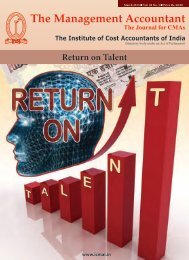This Issue - Icwai
This Issue - Icwai
This Issue - Icwai
Create successful ePaper yourself
Turn your PDF publications into a flip-book with our unique Google optimized e-Paper software.
COVER COVER ARTICLE<br />
ARTICLE<br />
and process variety—where excellence in manufacturing<br />
process was not critical for success—a single<br />
costing system might have sufficed” (p. 2). But clearly,<br />
this is no longer possible now because, Kaplan and<br />
Cooper (1998: p.1) argues, changes in business since<br />
the mid-1970s triggered by global competition and<br />
technological innovations have led to the striking<br />
innovations in the use of financial and non-financial<br />
information in organisations. Organisations, therefore,<br />
in a bid to find their own niche, must undertake<br />
journey through the four sequential stages illustrated<br />
by Kaplan and Cooper (1998 : p. 12).<br />
In relation to the four-stage model of cost system<br />
design, an analysis of the USALI would reveal that it<br />
is apparently a disciplined approach to producing a<br />
clear, usable information for performance evaluation<br />
of the different areas of hospitality business (Quigley<br />
and Angwin, 2011), but a deeper analysis would reveal<br />
that so far as the information need of the management<br />
is concerned, at best it represents a transition from<br />
Stage I to Stage II in the cost management system design<br />
suggested by Kaplan and Cooper.<br />
For instance, De Franco (1997) has found that allmost<br />
all the hotels use traditional budgets for planning<br />
annual operations, controlling of costs, and for<br />
coordinating activities of various parts of the hotels.<br />
About half of the companies use zero-base budgets,<br />
while a few use flexible budgets (Schidgall et al, 1996).<br />
Most USALI users make use of traditional, profitability<br />
measures for performance evaluation, e.g.<br />
● Average Room Rate = Rooms Revenue divided<br />
by Rooms Occupied<br />
● Average Food Check = Total Food Revenue<br />
divided by Number of Covers (i.e. guests served in<br />
the food operation during the period).<br />
In order to have a proper check on the inventory<br />
of rooms and their utilizations, USAL has recently<br />
started using a new indicator called RevPar (which<br />
stands for revenue per available room). RevPar is<br />
calculated as Room revenue divided by total rooms<br />
available. USALI uses the entire inventory of rooms<br />
as a denominator (including those not ready for use)<br />
to indicate whether the inventory of rooms is being<br />
managed properly. In a recent survey by Pavlots<br />
et al. (2007) have found that a majority of the hotel<br />
organizations have been using traditional cost<br />
accounting system like absorption costing and costvolume-profit<br />
(CVP) analysis, with quite a few using<br />
standard cost accounting system.<br />
Hospitality organisations are basically service<br />
organisations. However, notwithstanding the<br />
observation of Kaplan and Cooper (1998 : P. 231) that<br />
service companies are ideal candidates for activity-<br />
based costing, the results of many surveys, however,<br />
indicate that the use of activity-based costing in the<br />
hotel organisations is very few and far between.<br />
As a service industry, hospitality industry has a<br />
high proportion of fixed costs, with approximately<br />
three-quarters of the total cost of hotels being<br />
uncontrollable (Kotas, 1997). The room department<br />
has a fixed cost of 15-20% in relation to its sales<br />
volumes, while food and beverage operations entail<br />
relatively high fixed costs in the form of kitchen and<br />
restaurant wages. <strong>This</strong> means that allocation of costs<br />
can have a significant impact on determining the<br />
financial performance. The merits of activity-based<br />
costing over the traditional cost accounting method<br />
has been extolled, amongst others, by Kaplan and<br />
Cooper (1998) and Shank and Govindarajan (1993).<br />
But unfortunately, with all the glaring defects of<br />
improper and misleading cost allocation of traditional<br />
cost accounting system, activity-based costing plays<br />
second fiddle in the hospitality organisations. The<br />
consequence of such action is well demonstrated by<br />
Tsai et al (2010) who have recently studied the<br />
advantage of using ABC of a country inn in Taiwan.<br />
The study gives better insight into the customer costs<br />
for each market segment in order to offer more<br />
accurate cost information for innkeepers to make<br />
better managerial decision. Also, this study compares<br />
the ABC with the traditional costing method, and<br />
concludes that the ABC method is a more suitable<br />
and appropriate tool than traditional accounting<br />
method in a country inn.<br />
Exhibit # 3. Comparing ABC with Traditional<br />
Accounting<br />
N.T. Dollars<br />
Cost<br />
Traditional accounting<br />
allocation :<br />
Lodging<br />
Product<br />
Hot-Spring Dining<br />
Overhead 99,640 597,842 1,693,885<br />
(Assigning by direct labor hours) (240hr) (1440hr) (4080hr)<br />
Direct Labor 30,000 180,000 623,000<br />
Direct Materials 61,137 116,843 1,032,498<br />
Outside laundry 33,000<br />
Hot-spring water<br />
Total cost on traditional<br />
5,049<br />
accounting basis 223,777 899,734 3,349,383<br />
Mean number of customers 1,440 56,750 33,240<br />
Unit cost per customer 155.4 15.85 100.76<br />
Unit cost per customer in ABC 306.21 31.64 67.28<br />
The Management Accountant |September 2011 755




